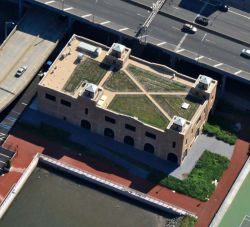Mill Pond Park
The Daily Plant : Tuesday, December 21, 2010
Power House Building in Mill Pond Park Awarded Prestigious LEED® Green Building Certification

Tishman-DMJM Harris JV
On Monday, December 20, NYC Parks & Recreation announced that the Power House, a restored historic 25,800-square-foot building in Mill Pond Park in the Bronx, has been awarded LEED® Gold established by the U.S. Green Building Council (USGBC) and verified by the Green Building Certification Institute (GBCI). LEED is the nation’s preeminent program for the design, construction and operation of high performance green buildings. The Power House, which originally supported the food refrigeration warehouse at the Bronx Terminal Market, was restored and re-opened in March 2010 as part of the Yankee Stadium Redevelopment Project. The $13.7 million Power House is located in Mill Pond Park, a 10-acre waterfront park created along the Harlem River, which is the first significant waterfront park to open along the Bronx bank of the Harlem River in recent years.
“New York City parks are at the forefront of sustainable design in New York City, across the country, and around the world” said Parks Commissioner Adrian Benepe. “We are a leader, in partnership with hundreds of experts and environmental organizations, in making the city's parkland and park facilities green laboratories for cutting edge landscape architecture, architecture, engineering, and planning. In keeping with Mayor Bloomberg's PlaNYC 2.0 objective to advance green initiatives, we will continue to innovate and create practical solutions on energy conservation, storm water management and water use reduction, and CO2 emissions reduction.”
The Power House currently features a green roof with plantings visible from the nearby Major Deegan Expressway, public restrooms and office space on the first floor for the Parks Department. The concessionaire is working to outfit the Power House’s indoor café, tennis clubhouse and locker room. The building’s second floor includes 12,500 square feet of space for public programming.
The Power House achieved LEED certification for energy use, lighting, water and material use as well as incorporating a variety of other sustainable strategies. By using less energy and water, LEED certified buildings save money for families, businesses and taxpayers; reduce greenhouse gas emissions; and contribute to a healthier environment for residents, workers and the larger community.
LEED certification of the Power House was based on a number of green design and construction features that positively impact the project itself and the broader community. These features include:
• Green Roof – Over 52% of the total roof area is vegetated.
• Native Plantings – 23% of the total site area has been restored with native species.
• Stormwater Management – results in a 25% rate decrease and 50% quantity decrease in runoff from calculated pre-project conditions.
• Reduced Water Use – reduced potable water use by 43% from a calculated baseline design through the installation of low-flow water closets, low-flow urinals, ultra low-flow lavatories, and a low flow sink.
• Building Reuse – Over 80% of the existing wall, floor, and roof elements has been maintained.
• Recycled Content – Over 23% of the total building materials content, by value, have been manufactured using recycled materials.
• Certified Wood – 100% of the total wood based building materials are harvested from FSC certified forests.
As part of the Yankee Stadium Redevelopment Program, the City invested $64 million to transform this decayed industrial waterfront into the lush new ten-acre Mill Pond Park. In addition to the Power House, Mill Pond Park features picnic & grass areas, overlooks with waterfront views, sixteen Deco Turf tennis courts, and an esplanade to unite the site (Deco Turf is the surface used on tennis courts at the world's most prestigious events including the Olympic Games and the U.S. Open). The scope of work also included the restoration of a sea wall and piers along the river’s edge. Other amenities include an outdoor classroom, two water runnels, spray showers, and a sand play area. Landscaped plantings line the ADA-accessible pathways throughout the park.
The preservation and renovation of the Power House was implemented by NYC Economic Development Corporation, with design team from Stantec, construction management by LiRO, and Program Managers AECOM & Tishman.
Upon petition in 1813, Robert Macomb was granted permission by the Legislature to erect a dam across the Harlem River from Bussing's Point in Manhattan to Devoe’s Point in Westchester, making the Harlem River and Spuyten Duyvil Creek a large mill pond – or body of water used as a reservoir for a water-powered mill – to furnish power for milling purposes. For more information about Mill Pond Park and the Power House, visit www.nyc.gov/parks.
QUOTATION FOR THE DAY
“Interpretation is the revenge of the intellectual upon art.”
Susan Sontag
(1933 – 2004)
Check out your park's Vital Signs
Clean & Safe
Green & Resilient
Empowered & Engaged Users
Share your feedback or learn more about how this park is part of a
Vital Park System


